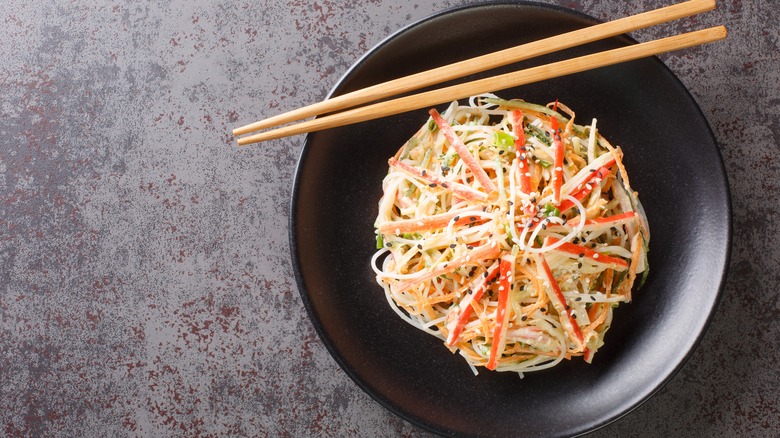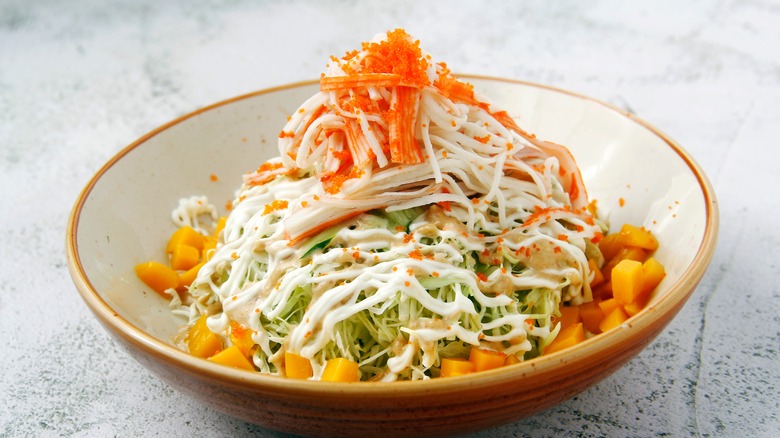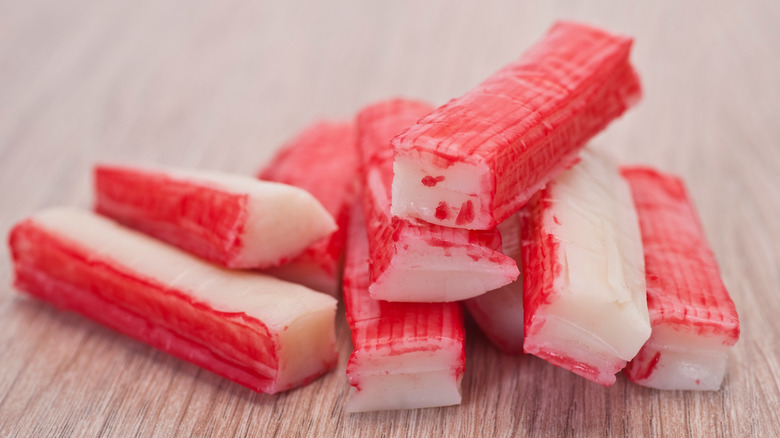What Is Kani Salad And What Is It Made Of?
Crab is one of those ingredients that you'll find in cultures all across the globe. Nature loves creating crabs, after all, which is why crabs just keep evolving — and people just keep eating them. Different types of crab need to be cooked differently, of course, but that doesn't seem to impact their universality. From Maryland's crab pretzel and crab quesadillas to Venetian crab linguine, you'll find creative uses of crustaceans anywhere crabs are found (which is seemingly everywhere).
This brings us to Japan's kani salad. Why is it called kani salad? You might've guessed, given the name: "Kani" is the Japanese word for crab. Unlike a lot of crab dishes, though, kani salad can be made with either imitation crab or real crab (if you do that with Baltimore crab cakes, you might be immediately barred from ever entering the state of Maryland). At its core, kani salad comes down to something like the Japanese version of coleslaw: A mayonnaise-based cold salad featuring vegetables and sweet, tasty seafood.
We're not sure where it came from
It's not actually clear where kani salad originally came from. We know Japanese cuisine has involved crab for well over a millennium; there are poems from 600-700 CE which make it clear crab (typically snow crab from the Sea of Japan) has been a part of the Japanese diet for at least that long. Kanikama, however — imitation crab sticks made from surimi – came into existence in the 1970s, and though we don't know who invented kani salad, there's reason to suspect the imitation crab version was the original since they both emerged at around the same time.
Kani salad — which is typically a side dish more than a main course — ultimately comes down to just a few relatively customizable ingredients. Crab (or imitation crab) is the obvious one, but it also has to involve mayonnaise. You can theoretically use any mayo for this, but the unique, slightly sweet tang of a Japanese mayo such as kewpie will go best. You also want to add some julienned vegetables, although which you go with is up to you; typically, cucumber and carrots are the most common for the crunch they provide. From there, it's common (although not necessary) to top it with something that provides a bit more texture, such as panko breadcrumbs or fish roe.
It's OK if your kani salad is made with imitation crab
A kani salad will be better with actual crab because everything is better with actual crab; crab is delicious. But you can still make it with imitation crab, and most prepackaged versions you find will use this stuff because it's way cheaper and travels better, freezing surprisingly well. Honestly, it's harder to find kani salad with real crab than the other way around unless you're near a place where both crab is freshly caught and there are Japanese restaurants to make it. People believe many myths about imitation crab, and the most persistent one is probably that it's not even fish (it is: It's just cheap fish like pollock or cod). So, if you eat a kani salad with imitation crab instead of the real stuff, it's not vegan, and you're still having a seafood dinner.
However you make your kani salad, though, it's a light, refreshing snack that will brighten your day. If you're interested in trying Japanese cuisine but are wary of the raw fish in sushi and sashimi, kani salad is a great place to start.


